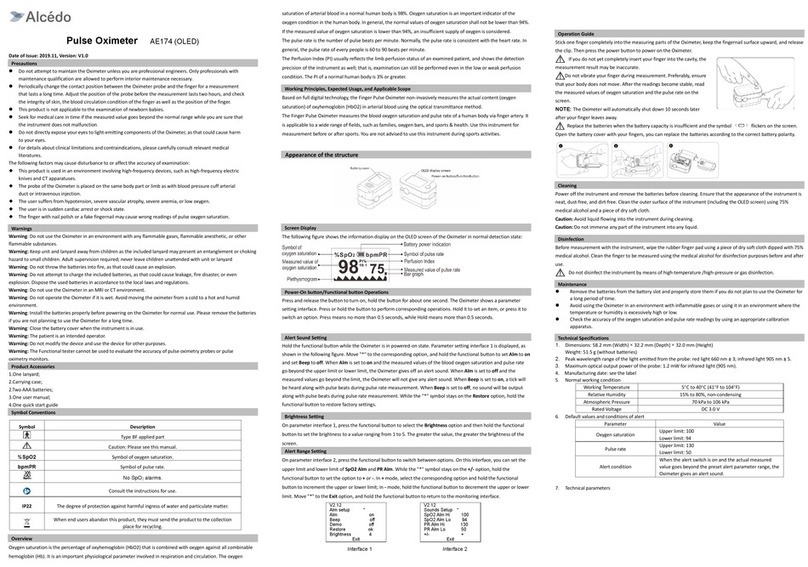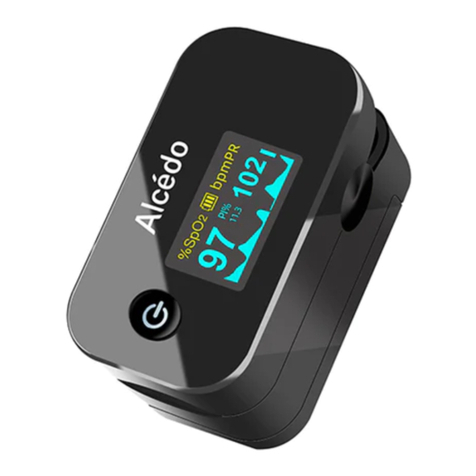
Pulse Oximeter AE174 (OLED)
Date of Issue: 2019.11, Version: V1.0
Precauons
Do not aempt to maintain the Oximeter unless you are professional engineers. Only professionals with
maintenance qualicaon are allowed to perform interior maintenance necessary.
Periodically change the contact posion between the Oximeter probe and the nger for a measurement
that lasts a long me. Adjust the posion of the probe before the measurement lasts two hours, and check
the integrity of skin, the blood circulaon condion of the ger as well as the posion of the nger.
This product is not applicable to the examinaon of newborn babies.
Seek for medical care in me if the measured value goes beyond the normal range while you are sure that
the instrument does not malfuncon.
Do not directly expose your eyes to light-emig components of the Oximeter, as that could cause harm
to your eyes.
For details about clinical limitaons and contraindicaons, please carefully consult relevant medical
literatures.
The following factors may cause disturbance to or aect the accuracy of examinaon:
This product is used in an environment involving high-frequency devices, such as high-frequency electric
knives and CT apparatuses.
The probe of the Oximeter is placed on the same body part or limb as with blood pressure cuarterial
duct or intravenous injecon.
The user suers from hypotension, severe vascular atrophy, severe anemia, or low oxygen.
The user is in sudden cardiac arrest or shock state.
The ger with nail polish or a fake ngernail may cause wrong readings of pulse oxygen saturaon.
Warnings
Warning: Do not use the Oximeter in an environment with any ammable gases, ammable anesthec, or other
ammable substances.
Warning: Keep unit and lanyard away from children as the included lanyard may present an entanglement or choking
hazard to small children. Adult supervision required; never leave children unaended with unit or lanyard
Warning: Do not throw the baeries into re, as that could cause an explosion.
Warning: Do not aempt to charge the included baeries, as that could cause leakage, re disaster, or even
explosion. Dispose the used baeries in accordance to the local laws and regulaons.
Warning: Do not use the Oximeter in an MRI or CT environment.
Warning: Do not operate the Oximeter if it is wet. Avoid moving the oximeter from a cold to a hot and humid
environment.
Warning: Install the baeries properly before powering on the Oximeter for normal use. Please remove the baeries
if you are not planning to use the Oximeter for a long me.
Warning: Close the baery cover when the instrument is in use.
Warning: The paent is an intended operator.
Warning: Do not modify the device and use the device for other purposes.
Warning: The Funconal tester cannot be used to evaluate the accuracy of pulse oximetry probes or pulse
oximetry monitors.
Product Accessories
1.One lanyard;
2.Carrying case;
2.Two AAA baeries;
3.One user manual;
4.One quick start guide
Symbol Convenons
Cauon: Please see this manual.
Symbol of oxygen saturaon.
No SpO2alarms.
Consult the instrucons for use.
IP22 The degree of protecon against harmful ingress of water and parculate maer.
When end users abandon this product, they must send the product to the collecon
Overview
Oxygen saturaon is the percentage of oxyhemoglobin (HbO2) that is combined with oxygen against all combinable
hemoglobin (Hb). It is an important physiological parameter involved in respiraon and circulaon. The oxygen
saturaon of arterial blood in a normal human body is 98%. Oxygen saturaon is an important indicator of the
oxygen condion in the human body. In general, the normal values of oxygen saturaon shall not be lower than 94%.
If the measured value of oxygen saturaon is lower than 94%, an insucient supply of oxygen is considered.
The pulse rate is the number of pulse beats per minute. Normally, the pulse rate is consistent with the heart rate. In
general, the pulse rate of every people is 60 to 90 beats per minute.
The Perfusion Index (PI) usually reects the limb perfusion status of an examined paent, and shows the detecon
precision of the instrument as well; that is, examinaon can s be performed even in the low or weak perfusion
condion. The PI of a normal human body is 3% or greater.
Working Principles, Expected Usage, and Applicable Scope
Based on full digital technology, the Finger Pulse Oximeter non-invasively measures the actual content (oxygen
saturaon) of oxyhemoglobin (HbO2) in arterial blood using the opcal transmiance method.
The Finger Pulse Oximeter measures the blood oxygen saturaon and pulse rate of a human body via ger artery. It
is applicable to a wide range of elds, such as families, oxygen bars, and sports & health. Use this instrument for
measurement before or aer sports. You are not advised to use this instrument during sports acvies.
Appearance of the structure
Screen Display
The following gure shows the informaon display on the OLED screen of the Oximeter in normal detecon state:
Power-On buon/Funconal buon Operaons
Press and release the buon to turn on, hold the buon for about one second. The Oximeter shows a parameter
seng interface. Press or hold the buon to perform corresponding operaons. Hold it to set an item, or press it to
switch an opon. Press means no more than 0.5 seconds, while Hold means more than 0.5 seconds.
Alert Sound Seng
Hold the funconal buon while the Oximeter is in powered-on state. Parameter seng interface 1 is displayed, as
shown in the following gure. Move "*" to the corresponding opon, and hold the funconal buon to set Alm to on
and set Beep to o. When Alm is set to on and the measured values of the blood oxygen saturaon and pulse rate
go beyond the upper limit or lower limit, the Oximeter gives oan alert sound. When Alm is set to off and the
measured values go beyond the limit, the Oximeter will not give any alert sound. When Beep is set to on, a ck will
be heard along with pulse beats during pulse rate measurement. When Beepis set to o, no sound will be output
along with pulse beats during pulse rate measurement. While the "*" symbol stays on the Restore opon, hold the
funconal buon to restore factory sengs.
Brightness Seng
On parameter interface 1, press the funconal buon to select the Brightness opon and then hold the funconal
buon to set the brightness to a value ranging from 1 to 5. The greater the value, the greater the brightness of the
screen.
Alert Range Seng
On parameter interface 2, press the funconal buon to switch between opons. On this interface, you can set the
upper limit and lower limit of SpO2 Alm and PR Alm. While the "*" symbol stays on the +/- opon, hold the
funconal buon to set the opon to +or -. In +mode, select the corresponding opon and hold the funconal
button to increment the upper or lower limit; in -mode, hold the funconal buon to decrement the upper or lower
limit. Move "*" to the Exit opon, and hold the funconal buon to return to the monitoring interface.
Interface 1 Interface 2
Operaon Guide
Sck one nger completely into the measuring parts of the Oximeter, keep the gernail surface upward, and release
the clip. Then press the power buon to power on the Oximeter.
If you do not yet completely insert your nger into the cavity, the
measurement result may be inaccurate.
Do not vibrate your nger during measurement. Preferably, ensure
that your body does not move. Aer the readings become stable, read
the measured values of oxygen saturaon and the pulse rate on the
screen.
NOTE: The Oximeter will automacally shut down 10 seconds later
aer your nger leaves away.
Replace the baeries when the baery capacity is insucient and the symbol ckers on the screen.
Open the baery coverwith your gers, you can replace the baeries according to the correct baery polarity.
Cleaning
Power othe instrument and remove the baeries before cleaning. Ensure that the appearance of the instrument is
neat, dust-free, and dirt-free. Clean the outer surface of the instrument (including the OLED screen) using 75%
medical alcohol and a piece of dry socloth.
Cauon: Avoid liquid owing into the instrument during cleaning.
Caution: Do not immerse any part of the instrument into any liquid.
Disinfecon
Before measurement with the instrument, wipe the rubber ger pad using a piece of dry socloth dipped with 75%
medical alcohol. Clean the nger to be measured using the medical alcohol for disinfecon purposes before and aer
use.
Do not disinfect the instrument by means of high-temperature /high-pressure or gas disinfecon.
Maintenance
Remove the baeries from the baery slot and properly store them if you do not plan to use the Oximeter for
a long period of me.
Avoid using the Oximeter in an environment with inammable gases or using it in an environment where the
temperature or humidity is excessively high or low.
Check the accuracy of the oxygen saturation and pulse rate readings by using an appropriate calibraon
apparatus.
Technical Specicaons
1. Dimensions: 58.2 mm (Width) ×32.2 mm (Depth) ×32.0 mm (Height)
Weight: 51.5 g (without baeries)
2. Peak wavelength range of the light emied from the probe: red light 660 nm ±3; infrared light 905 nm ±5.
3. Maximum opcal output power of the probe: 1.2 mW for infrared light (905 nm).
4. Manufacturing date: see the label
5. Normal working condion
5 C to 40 C (41 F to 104 F)
15% to 80%, non-condensing
6. Default values and condions of alert
Oxygen saturaon
Upper limit: 100
Lower limit: 94
Pulse rate Upper limit: 130
Alert condion
When the alert switch is on and the actual measured
value goes beyond the preset alert parameter range, the
Oximeter gives an alert sound.
7. Technical parameters
Alm setup *
Alm on
Beep off
Demo off
Restore ok
Brightness 4
Sounds Setup *
SpO2 Alm Hi 100
SpO2 Alm Lo 94
PR Alm Hi 130
PR Alm Lo 50
+/- +






















